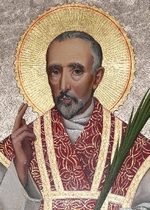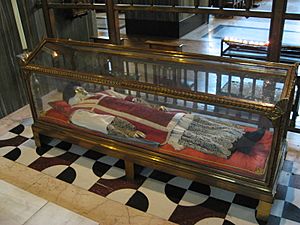John Southworth (martyr) facts for kids
Quick facts for kids SaintJohn Southworth |
|
|---|---|
 |
|
| Martyr | |
| Born | c. 1592 Lancashire, England |
| Died | 28 June 1654 Tyburn, London, England |
| Venerated in | Catholic Church |
| Beatified | 15 December 1929, Rome by Pope Pius XI |
| Canonized | 25 October 1970, Rome by Pope Paul VI |
| Major shrine | Westminster Cathedral |
| Feast | 27 June (Diocese of Westminster, 25 October (with the Forty Martyrs of England and Wales) |
| Attributes | chasuble, martyr's palm |
| Patronage | priests |
John Southworth (born around 1592 in Lancashire, England – died June 28, 1654, in Tyburn, London) was an English Catholic priest. He is known as a martyr, which means he died for his religious beliefs. He is one of the Forty Martyrs of England and Wales, a group of people honored for their faith during a difficult time in English history.
Contents
Early Life and Education
John Southworth grew up in Lancashire, England. His family lived at Samlesbury Hall. They were Catholic and chose to pay large fines instead of giving up their faith.
He went to study at the English College in Douai, which is in northern France. This college was a place where English Catholics could train to become priests. At that time, a law in England made it illegal for priests trained abroad to return to England. This law also made it illegal for anyone to help such priests.
Ministry and Arrests
John Southworth became a priest before he returned to England in October 1619. He worked there until 1624, when he was asked to serve as a chaplain to Benedictine nuns in Brussels.
About a year later, he came back to Lancashire. In 1627, he was arrested and put in Lancaster Castle. Another priest, Edmund Arrowsmith, was also imprisoned there. Arrowsmith was executed in 1628. Southworth was later moved to The Clink prison in London. He was sentenced to death for practicing his Catholic faith. However, in 1630, Queen Henrietta Maria stepped in. She insisted that he and seventeen other prisoners be sent to the French ambassador and then deported to France.
By 1636, John Southworth had secretly returned to England. He lived in Clerkenwell, London, during a terrible plague epidemic. He and another priest, Henry Morse, helped many sick people in Westminster. They also raised money for families who had lost loved ones to the plague.
Southworth was arrested again in November 1637. He was sent to the Gatehouse Prison and then back to The Clink, where he stayed for three years. He was arrested four times in total. Three times, he was released by the Secretary of State, Sir Francis Windebank, because the Queen asked for it. The fourth time, he managed to escape. From 1640 to 1654, he continued his secret work as a priest.
Final Arrest and Execution
John Southworth was arrested once more during the English Interregnum, a period when England was ruled without a king. He was tried at the Old Bailey court under old laws against Catholic priests. He admitted that he was a priest and had been practicing his faith. Because of this, he was sentenced to death. He was executed at Tyburn, London.
Legacy and Veneration

After his execution, the Spanish ambassador arranged for his body to be returned to Douai for burial. His body was prepared to help preserve it for the journey. Later, during the French Revolution, his body was buried in an unmarked grave to keep it safe.
In 1927, his grave was found, and his remains were brought back to England. Today, they are kept in the Chapel of St George and the English Martyrs inside Westminster Cathedral in London. This special container for his remains is called a reliquary.
John Southworth was declared "blessed" (beatified) in 1929. In 1970, he was officially recognized as a saint (canonized) by Pope Paul VI. He is one of the Forty Martyrs of England and Wales. His feast day, a special day to remember him, is celebrated on June 27 in the Westminster diocese. He is also considered a patron saint of priests.
In 2014, a group called The Guild of Saint John Southworth was started at Westminster Cathedral. Its members are volunteers who welcome visitors, answer questions, and offer tours of the cathedral for free.
See also
 In Spanish: Juan Southworth para niños
In Spanish: Juan Southworth para niños

